Guest blogger: Mark Clayton.
When Catholic Movement workers vandalised Toowong's Canon Garland war memorial last month there followed, predictably, a chorus of outrage. Politicians and Returned Services League (RSL) leaders were among the first to express their disgust, much as those arrested might have hoped. These disbelieving voices, united in their shock that any one (or number) of Australians could have carried out such a depraved act, were also meant as a clarion call to those who hold dear the Anzac values. Courage, sacrifice and comradeship so it seemed were under attack in suburban Toowong, but not for the first time. A few minutes Googling will reveal that war memorials the world over have always been targeted by both thoughtless and thoughtful attackers, many more having also been accidentally damaged.
These counter narratives, being unpopular with national myth makers, are usually quickly suffocated especially in countries like Australia which have forged strong inter-dependencies between national identity and military commemoration. And so last month’s ideologically motivated assault here in Brisbane was promptly dismissed as a cowardly and unprecedented obscenity, rather than just the latest of several such indignities perpetrated at that site throughout the past century. The citizens of Toowong had in fact no sooner finished constructing their new memorial when, in 1925, ‘it was defaced and disfigured in a most disgraceful manner...The chains around the monument were all smashed, and the bolts taken out of the panels. The marble panels were also disgracefully marked and indecently written on’. Then in 1932, under the headline ‘Have our war heroes been forgotten?’, Brisbane's Telegraph also took aim at the Brisbane Council for allowing its memorial to fall into disrepair.
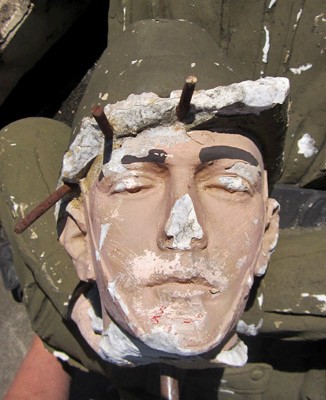
In common with many diggers, these shattered remains of the former Manly memorial were also carved from Italian marble. It was destroyed by vandals in 1990 who tied it by chain to their car and ripped it from its foundations. They were charged and found guilty, but not made to pay for the damages. Dismembered and beheaded, its shattered remains have been stored ever since at Council’s Herbert Street Depot in Lota. Image from Dr Richard Walding's Manly War Memorial website.
With undisguised frustration, Town Clerk Stanley Travill responded by pointing out ‘that monuments in other parts of Brisbane had been subjected to shocking vandalism. Some time ago hooligans had removed the lead lettering of the names of soldiers inscribed on the base of the Ithaca memorial, and the City Council met the problem by restoring the names by the use of painted letters. A day or two ago a report had been made to him that two of the scrolled tablets bearing the names of soldiers had been removed from the memorial in Mowbray Park, East Brisbane, and one had been broken…..The public, said Mr. Travill, had shown enthusiasm in erecting memorials, the majority of which had been placed in public parks or other public places, and now, it would seem, the responsibility of maintaining them had fallen on the council.’
It was just a few years later, in 1935, that Stones Corner residents attending their local Anzac Day ceremony awoke to discover that a pillar had been smashed off one of the memorial gates at Langlands Park, its ironwork having also been twisted and parts removed. Across town that same day, Balmoral RSL sub-committee members arrived early for the Anzac Day ceremony to discover that vandals had systematically removed from the Memorial Avenue trees all seventy-six lead plaques bearing the names of those locals killed during the 1914 - 1918 War.
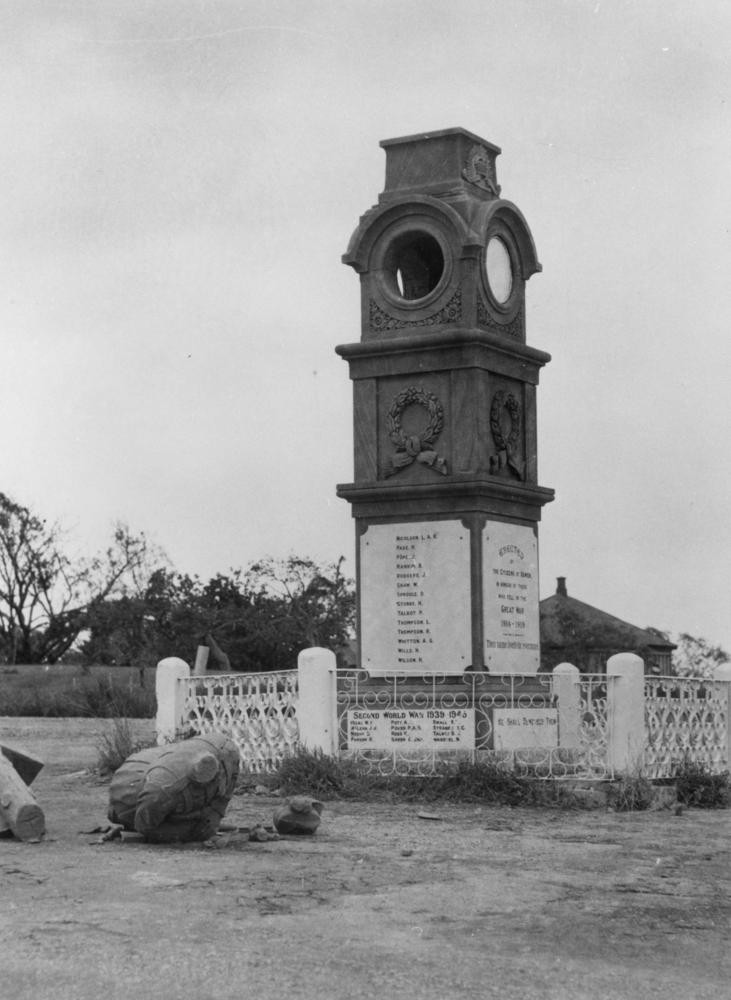
Although damaged by vandals in 1939, and again in 1941, Bowen’s memorial suffered most during the cyclone of 1958, the after effects of which are evident here. John Oxley Library, State Library of Queensland, Neg. 25780
Avenues of honour were in fact among the first memorials singled out by vandals, many of the young trees lining Towoomba’s recently named Anzac Avenue having been uprooted and carried away in February 1920, even before the last Australians serving overseas had returned home.
Far from being isolated incidents, albeit difficult at times to comprehend, there is abundant evidence to show that Australian war memorials have always been desecrated. With monotonous predictability, in every state and territory, similar expressions of outrage have been heard - and rewards offered - almost every year throughout the last century. And while Great War Memorials have most often been targeted, the same disdain has been shown for those relating to earlier - and later - conflicts.
In 1910 the Boer War statue in Watsons Bay commemorating the death of Lieutenant Vaucluse was pulled down and smashed, suffering a similar fate just five years later when its head was knocked off by off by a large stone projectile. Great War Memorials have suffered the most damage, both accidental and intentional, largely because there are an estimated 3,000 of these prominently displayed throughout the country.
Potentially divisive and threatening, political and ideologically-motivated attacks on war memorials are uncommon in Australia, the usual presumption here being that most vandalism is caused by hooligans and delinquent youths….’Surely’ lamented one journalist in 1920, ‘our homes and our schools can do something in the direction of training our young people to respect other people's property and particularly that which is sacred to many.’
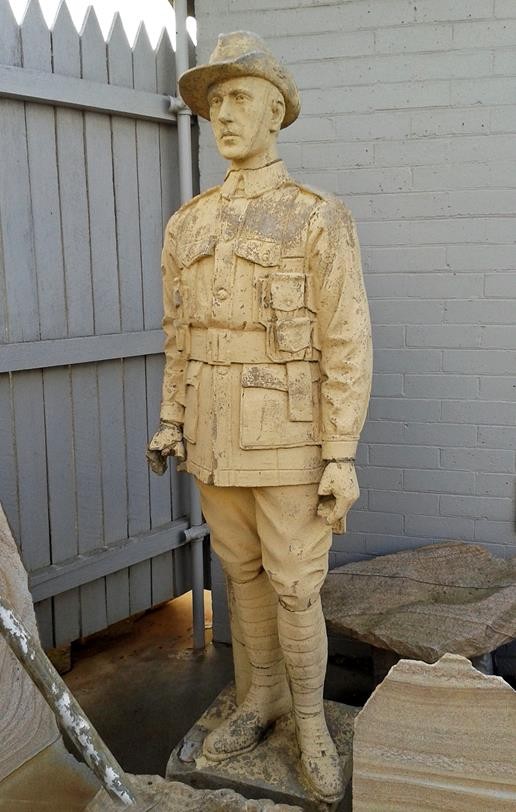
Kaimkillumbum’s memorial was toppled by a truck, the shattered remains (seen here) later being crudely reassembled by the Toowoomba stonemasonry firm of R C Ziegler. Having erected the original the 1920, Ziegler’s were recommissioned to install a replacement which they were able to replicate from their original plans. Image by Mark Clayton
Though less common, accidental damage has also become a significant problem especially for municipal town planners and traffic managers. War memorials were commonly erected in the early 1920s at the intersection of major thoroughfares, when there were comparatively few motor vehicles. Traffic volumes have grown exponentially since then resulting, inevitably, in an increase in the number of collisions between moving vehicles, and static memorials. Those monuments that weren’t irreparably damaged were typically relocated such that it is now uncommon to find any that are both undamaged, and sited still where they were originally erected.
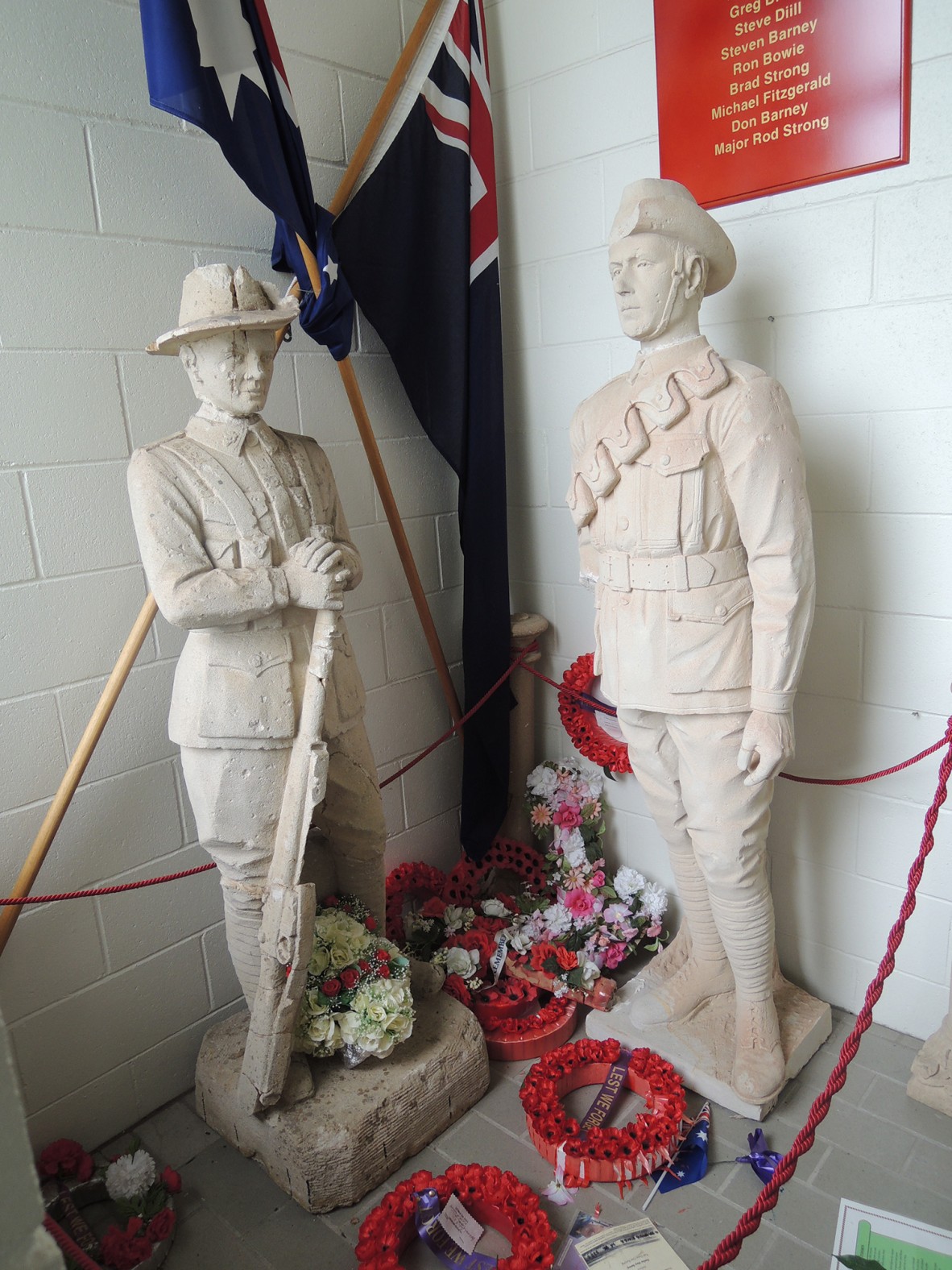
The Bundamba (left) and Ebb Vale memorials were both destroyed by vandals, in 2000 and 2008 respectively. The fragmented remains of both were later given to a local charitable organisations which has since created its own Anzac-like shrine. Image by Mark Clayton
A collision between the butcher’s van and another vehicle at Burleigh Heads in 1929 caused the Esplanade soldiers’ memorial to be damaged, neither vehicle being insured. Queensland only has three Boer War memorials, two of which have suffered repeated misfortune. That opposite the Trades Hall building in Upper Edwards Street was first damaged by a vehicle in March 1930, suffering a similar fate barely three years later when it was struck by a truck loaded with barbed wire…’The impact was so severe that the batteries were, flung from their holders beneath the floorboards. The whole of the body work was smashed, and the chassis was twisted and engine parts were flung on the roadway.’
Gatton’s South African war memorial was ‘practically demolished’ in September 1940 by a heavily laden transport truck, one local councillor being moved to describe the incident as ‘the greatest tragedy that has ever happened in this town.’ He went on to reject suggestions that it had been erected in the wrong place, noting that ‘The stone acted as an excellent "silent cop," and motorists were forced to go round it.’ This logic met with a wry observation from a fellow councillor ‘Not all of them, apparently’.
The citizens of Tigalpa were especially unfortunate, their plinth mounted stone digger having suffered the same indignity twice in as many months. In mid 1937 it was demolished by a wayward taxi, the shattered pieces being struck again, at night, even as council and the community were still deciding whether to rebuild and relocate. The driver involved in this last accident later claimed that ‘his lights failed temporarily. He was adjusting the wiring under the dashboard when the car struck the heap of stone.’
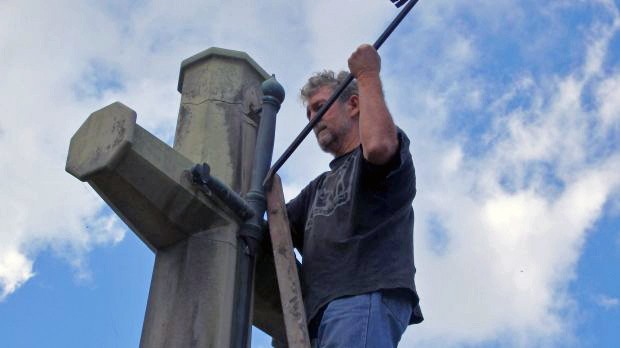
Catholic Worker movement members vandalising Toowong’s Cross of Sacrifice on Ash Wednesday this year. Image from article by Cameron Atfield, 'Religious fanatics charged over damage to Toowong war memorial', Brisbane Times, 2 March 2017.
Once the focus of highly charged political, religious, historical, aesthetic and ideological community debates war memorials are more than just commemorative waypoints, their size, type, location,and condition all indicating changing community attitudes, sentiments and values. Should you find yourself making the pilgrimage this Anzac Day, then take a moment to closely examine that all-too-familiar stone icon. Has its significance been altered by one or more relocations? Are there any telltale signs that it has been vandalised, or damaged and if not, then why? Perhaps it is looking too ‘new’ in which case, it could be one of the increasingly common Chinese imports. Like the proverbial axe that belonged to that other Australian legend, Ned Kelly, the head might be the only original part of that silent sentinel now looming above the huddled Anzac Day crowd.
Comments
Your email address will not be published.
We welcome relevant, respectful comments.